These last days I did an experiment, I wondered about the interest in the market for a specific B&W sensor, and I thought of 2 approaches to achieve.
The reasons for a specific B&W sensor are that in my opinion a Bayer sensor is not optimised for B&W photography. Keeping the same degree of complexity (number of photocaptors mainly) I think we can design a B&W sensor that improves the quality of results for this specific kind of photography because a Bayer sensor has design disadvatanges over a monochrome sensor for B&W such as:
- Irregular band pass filtering in 3 agressive channels (RGB)
- Lower optical efficiency because of the reduction of incident light power due to these filters filters
- High degree of interpolation (only 1 out of each 3 channel levels is captured)
- Multiple B&W conversion methods from RGB suggest none is 100% satisfactory
- The conversion process itself is an additional pain step in the B&W photographer workflow
I have thought of 2 approaches for a B&W sensor with improved quality over a Bayer version with the same number of photocells:
BASIC NON-INTERPOLATION B&W SENSORAll captors receive the entire visible spectrum. No interpolation is needed. Would be some kind of "B&W Foveon" sensor.
HDR B&W SENSOR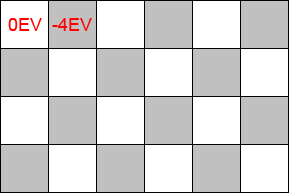
By allowing some degree of interpolation, we set ND -4EV microfilters over half the photocells. 2 independent B&W images will be produced that can be blent achieving a DR expansion of 4 f-stops.
______________________
NOTE: I consider the HDR sensor interpolation rate similar and even lower than that found in a Bayer sensor:

According to Y = 0,299R + 0,587G + 0,114B:
- Bayer RGGB sensor (left): (29,9% + 58,7% * 2 + 11,4%) / 4 =
39,7% captured information
- Proposed HDR B&W sensor (right): (100% + 0%) / 2 =
50% captured information
______________________
I will do a simulation to compare both methods (non-interpolated B&W and HDR B&W). I will start from 3 Bayer images shot over a high dynamic scene at: -2EV, 0EV, +2EV and converted to B&W through Y = 0,299R + 0,587G + 0,114B rule.
The 0EV shot being the 'correct' tradeoff exposure for a single shot on that scene.
BASIC NON-INTERPOLATION B&W SENSORFor the non-interpolation approach, the 0EV image converted to B&W will be straight the image to compare.
HDR B&W SENSORFor the HDR approach, I will decimate 50% of the values (discard them) in the -2EV and +2EV B&W images, according to the 2 sensor distributions.
Later the discarded values will be interpolated through the simplest interpolation algorithm, median of the 4 surrounding values:
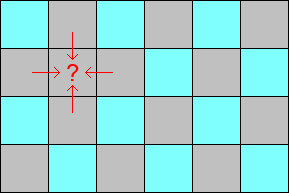
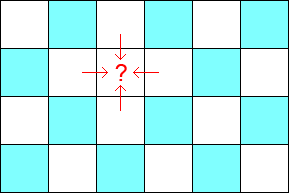
And then I will mix both images with the following blending criteria: for every pixel I keep the value from the +2EV image whenever possible. Should this value be close to saturation I would take the -2EV value. Of course exposure is corrected to match on both images prior to fusion.
Done this, I wil compare the result of both approaches in shadows, medium tones and highlights.
This is the scene under study:
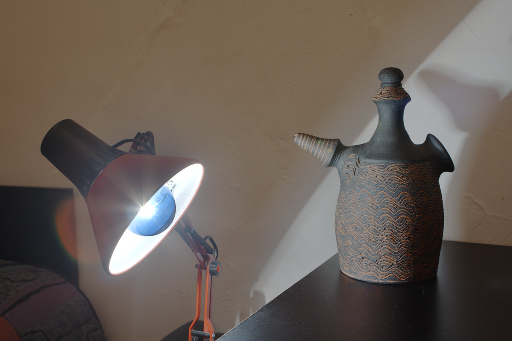
This is the comparision in different areas after the 2 B&W approaches have been done: crops at 100% (shadows), 50% (medium tones), 50% (highlights)
(when applied nearest neighbour rescaling to preserve SNR):
(left: non-interpolation B&W sensor, right: HDR B%W sensor)

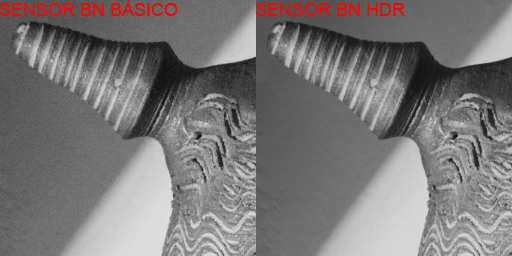
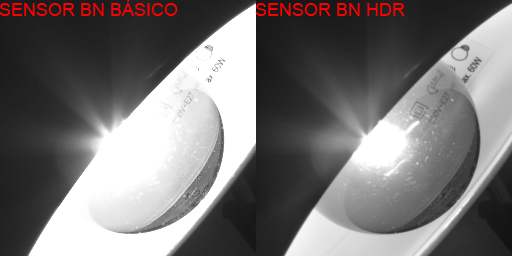
It seems the HDR approach performs much better than the basic in terms of DR and visible noise.
Let's find out if our simplistic interpolation algorithm (median of 4 values) for the HDR sensor means less detail accuracy:
Crops at 100%:
(up left: Bayer, up right: decimated B&W Bayer)
(down left: non-interpolation approach, down right: HDR approach)

There is some loss of sharpness in the fine detail (see the "60W" label) in the HDR approach when compared to the non-interpolated, even if the former is about to blow. Surely with a better interpolation strategy the differences would not be so visible.
This is the final aspect of the B&W HDR scene:
 QUESTIONS
QUESTIONS1. Do you think a B&W sensor has a place in the market if it really improves the quality of B&W shots of the equivalent complexity Bayer?
2. Do you think it is worth to allow some degree of interpolation and sharpness loss to enjoy the 4 f-stops DR expansion of the second approach?
3. Do you think these kind of sensors would need some orthocromatic filtering (maybe on the sensor, maybe on the lens) to produce adequate B&W images?
4. Why Leica does not design such a sensor type based camera?
In the original article (Spanish) you can see a 600% crop which reveals more clearly the sharpness loss in the high contrast fine detail areas of the "60W" label:
B&W SENSORS original article (Fig. 13). But think that I used a very basic emergency interpolation scheme (median).